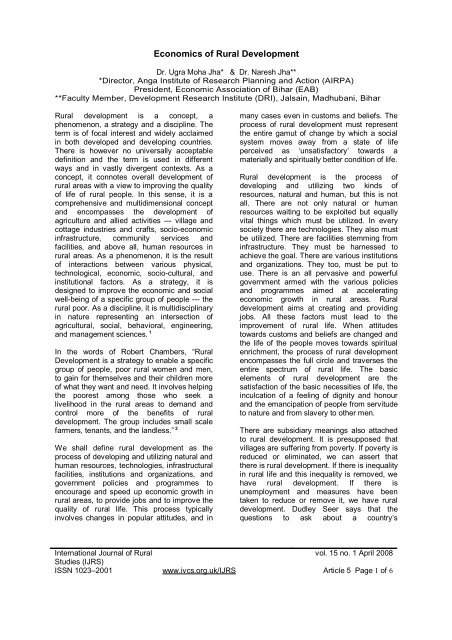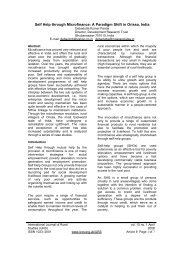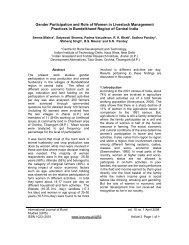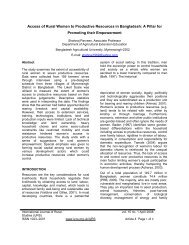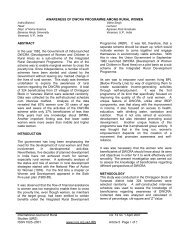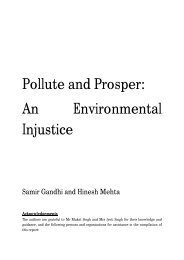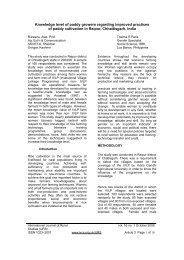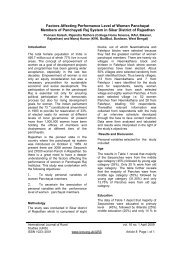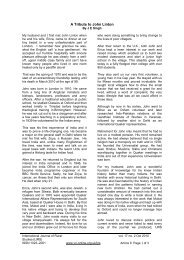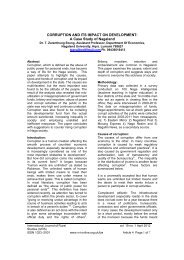5. Economics of Rural Development - Volunteers for Rural India
5. Economics of Rural Development - Volunteers for Rural India
5. Economics of Rural Development - Volunteers for Rural India
Create successful ePaper yourself
Turn your PDF publications into a flip-book with our unique Google optimized e-Paper software.
<strong>Economics</strong> <strong>of</strong> <strong>Rural</strong> <strong>Development</strong>Dr. Ugra Moha Jha* & Dr. Naresh Jha***Director, Anga Institute <strong>of</strong> Research Planning and Action (AIRPA)President, Economic Association <strong>of</strong> Bihar (EAB)**Faculty Member, <strong>Development</strong> Research Institute (DRI), Jalsain, Madhubani, Bihar<strong>Rural</strong> development is a concept, aphenomenon, a strategy and a discipline. Theterm is <strong>of</strong> focal interest and widely acclaimedin both developed and developing countries.There is however no universally acceptabledefinition and the term is used in differentways and in vastly divergent contexts. As aconcept, it connotes overall development <strong>of</strong>rural areas with a view to improving the quality<strong>of</strong> life <strong>of</strong> rural people. In this sense, it is acomprehensive and multidimensional conceptand encompasses the development <strong>of</strong>agriculture and allied activities --- village andcottage industries and crafts, socio-economicinfrastructure, community services andfacilities, and above all, human resources inrural areas. As a phenomenon, it is the result<strong>of</strong> interactions between various physical,technological, economic, socio-cultural, andinstitutional factors. As a strategy, it isdesigned to improve the economic and socialwell-being <strong>of</strong> a specific group <strong>of</strong> people --- therural poor. As a discipline, it is multidisciplinaryin nature representing an intersection <strong>of</strong>agricultural, social, behavioral, engineering,and management sciences. 1In the words <strong>of</strong> Robert Chambers, “<strong>Rural</strong><strong>Development</strong> is a strategy to enable a specificgroup <strong>of</strong> people, poor rural women and men,to gain <strong>for</strong> themselves and their children more<strong>of</strong> what they want and need. It involves helpingthe poorest among those who seek alivelihood in the rural areas to demand andcontrol more <strong>of</strong> the benefits <strong>of</strong> ruraldevelopment. The group includes small scalefarmers, tenants, and the landless.” 2We shall define rural development as theprocess <strong>of</strong> developing and utilizing natural andhuman resources, technologies, infrastructuralfacilities, institutions and organizations, andgovernment policies and programmes toencourage and speed up economic growth inrural areas, to provide jobs and to improve thequality <strong>of</strong> rural life. This process typicallyinvolves changes in popular attitudes, and inmany cases even in customs and beliefs. Theprocess <strong>of</strong> rural development must representthe entire gamut <strong>of</strong> change by which a socialsystem moves away from a state <strong>of</strong> lifeperceived as ‘unsatisfactory’ towards amaterially and spiritually better condition <strong>of</strong> life.<strong>Rural</strong> development is the process <strong>of</strong>developing and utilizing two kinds <strong>of</strong>resources, natural and human, but this is notall. There are not only natural or humanresources waiting to be exploited but equallyvital things which must be utilized. In everysociety there are technologies. They also mustbe utilized. There are facilities stemming frominfrastructure. They must be harnessed toachieve the goal. There are various institutionsand organizations. They too, must be put touse. There is an all pervasive and powerfulgovernment armed with the various policiesand programmes aimed at acceleratingeconomic growth in rural areas. <strong>Rural</strong>development aims at creating and providingjobs. All these factors must lead to theimprovement <strong>of</strong> rural life. When attitudestowards customs and beliefs are changed andthe life <strong>of</strong> the people moves towards spiritualenrichment, the process <strong>of</strong> rural developmentencompasses the full circle and traverses theentire spectrum <strong>of</strong> rural life. The basicelements <strong>of</strong> rural development are thesatisfaction <strong>of</strong> the basic necessities <strong>of</strong> life, theinculcation <strong>of</strong> a feeling <strong>of</strong> dignity and honourand the emancipation <strong>of</strong> people from servitudeto nature and from slavery to other men.There are subsidiary meanings also attachedto rural development. It is presupposed thatvillages are suffering from poverty. If poverty isreduced or eliminated, we can assert thatthere is rural development. If there is inequalityin rural life and this inequality is removed, wehave rural development. If there isunemployment and measures have beentaken to reduce or remove it, we have ruraldevelopment. Dudley Seer says that thequestions to ask about a country’sInternational Journal <strong>of</strong> <strong>Rural</strong>vol. 15 no. 1 April 2008Studies (IJRS)ISSN 1023–2001 www.ivcs.org.uk/IJRS Article 5 Page 1 <strong>of</strong> 6
development are: What has been happening topoverty? What has been happening tounemployment? What has been happening toinequality? If all three <strong>of</strong> these have declinedfrom high levels, then beyond doubt this hasbeen a period <strong>of</strong> development <strong>for</strong> the countryconcerned. If one or two <strong>of</strong> these centralproblems have been growing, it would bestrange to call the result “development” even ifper capita income doubled.In an agrarian country, rural development is <strong>of</strong>prime importance. There is no nationaldevelopment without rural development andthere is no rural development withoutagricultural development.<strong>Rural</strong> development means development <strong>of</strong>agriculture as well as development <strong>of</strong> alliedactivities such as village and cottageindustries, handicrafts, community servicesand facilities and economic infrastructure. Itmeans development and utilization <strong>of</strong> humanresources found in rural life. It stands <strong>for</strong>development and utilization <strong>of</strong> naturalresources that are available in village life. Itencompasses changes in the out look <strong>of</strong> thepeople. Existing beliefs are either displaced orconsiderably modified. Even customsprevailing in society and followed rigorouslyundergo alteration. There is a sea change inthe spiritual life <strong>of</strong> the people when there isrural development.Each factor in rural development is connectedwith every other factor. No one element leadsto a self – sufficing existence. Each influencesthe other and is influenced by that other. Mr.Katar Singh has this to say: “The process <strong>of</strong>rural development may be compared with atrend in which each coach pushes the oneahead <strong>of</strong> it and is in turn pushed by the onebehind, but it takes a powerful engine o makethe whole train move. The secret <strong>of</strong> success indevelopment lies in identifying and, if needed,developing a suitable engine to attach to thetrain. There are no universally valid guidelinesto identify appropriate engines <strong>of</strong> growth, if atall they exist. It is a choice which is influencedby time, space and culture.” 3Some writers have given objective, clear cutcriteria to identify whether there is ruraldevelopment. One is urbanization which is anindicator <strong>of</strong> economic development. If townsincrease in number and outnumber thevillages, some economists think that there hasbeen economic development. But this conceptcompletely does away with the rural scenario.Another is industrialization. The advocates <strong>of</strong>this theory hold that if there is industrializationon a big scale, it can modernize agricultureand give employment to people renderedredundant by the application <strong>of</strong> machinery toagriculture. The logical conclusion <strong>of</strong> suchthinking is to establish highly capital incentiveand automatic enterprises. This is just apingthe western model and going against theinterest <strong>of</strong> one’s own country. There are manycountries which have agricultural potential butacting under the notion that industrialization isthe kernel <strong>of</strong> development, they do not exploittheir agricultural potential and hence the basicneeds <strong>of</strong> the people remain unsatisfied.Imports <strong>of</strong> food grains take place at a hugecost. Agriculture is trapped in stagnation.People become victims <strong>of</strong> malnourishment.These theories militate against the standardconcept <strong>of</strong> rural development. Agriculture mustbe developed. There are very powerful andcogent reasons to support this point <strong>of</strong> view.Industrialization cannot be sustained withoutthe timely and sufficient availability <strong>of</strong> rawmaterials to many principal industries (e.g.jute, sugar and textile). A flourishing andprosperous agriculture also produces a surpluswhich is easily utilized in augmenting capital<strong>for</strong>mation, the basis <strong>of</strong> industrialization.Sometimes agriculture supplies <strong>for</strong>eignexchange much needed by developingcountries.A large part <strong>of</strong> the population earns itslivelihood through agriculture. In <strong>India</strong> nearlytwo-thirds <strong>of</strong> the people are dependent onagriculture. In the USA it is only 2% <strong>of</strong> thepopulation that is dependent on agriculture. Infact, cases are on record where the USAgovernment has paid its farmers not tocultivate the land and not to produce anythingfrom it. In such a country, rural developmentdoes not matter at all.Industry required laborers and they came fromthe agricultural population. When industrialdevelopment started, it required labourers butthere were no labourers to be found.International Journal <strong>of</strong> <strong>Rural</strong>vol. 15 no. 1 April 2008Studies (IJRS)ISSN 1023–2001 www.ivcs.org.uk/IJRS Article 5 Page 2 <strong>of</strong> 6
The labourers were not free. They were tied t<strong>of</strong>eudal lords. Hence laws were passed to freethem from feudal bondage and servitude. Butfreedom was not enough. The labourers mustjoin the capitalist factory. Here Governmentstepped in, passing several like the EnclosureAct, Vagrancy Act and Anti – beggary Act. Thecumulative effect <strong>of</strong> these acts was that thelabourers were compelled to join capitalistfactories. When we come to survey <strong>India</strong>nconditions, we find that industry is not plaguedby shortage <strong>of</strong> labor but has an abundantsupply. Agriculture can not absorb the labourwhich is available in rural areas. Hence ruraldevelopment is an absolute necessity to giveemployment to the surplus agriculturalpopulation in the agricultural sector itself.<strong>Rural</strong> development is a multifaceted and multidimensionalendeavour. It has no single allembracinggoal. It has a plethora <strong>of</strong> goals anda multiplicity <strong>of</strong> measuring rods to assess it. Ifper capita real GNP increases, we canreasonably conclude that there isdevelopment. But we have to see whether thisincrease in GNP percolates to rural areas.Another measuring rod focuses its attention onexpenditure. When there is high expenditureon civic amenities and facilities, we havedevelopment. If schools, hospitals, drainage,roads, parks etc. are constructed in thevillages, then there is real development. Allthese things contribute to the well – being andwelfare <strong>of</strong> the rural populace.Models <strong>of</strong> <strong>Rural</strong> <strong>Development</strong>Different countries have adopted differentstrategies to meet their goals <strong>of</strong> development.The USA developed on the basis <strong>of</strong> a freetrade capitalist economy - a market economy.The erstwhile Soviet Union developed bydiametrically opposed strategies. Itchampioned the command economy. China,too, followed this path and adopted publicownership <strong>of</strong> property. Sweden adopted a thirdstrategy. She combined capitalist and socialistelements, creating a mixed or welfareeconomy.The classical, liberal view <strong>of</strong> developmentpoints out that market is central todevelopment. It is the market economy whichideally optimizes economic welfare anddevelopment. Adam Smith in “Wealth <strong>of</strong>Nations” refers to an autonomous selfregulatingeconomy and this economy is takento be civil society. He advocates thesegregation <strong>of</strong> civil society from the politicaljurisdiction <strong>of</strong> the state. This civil society hasimmense capacity <strong>for</strong> self-regulation andshould be left unhindered. It has potential <strong>for</strong>achieving maximum benefits <strong>for</strong> all members<strong>of</strong> society who must be left free to pursue theirown interests. Civil society must be madeindependent <strong>of</strong> the state. Hence developmentbecomes synonymous with a negative state.Here development proceeds without anycentral direction. There are several features <strong>of</strong>this market model. The consumer is sovereign.Production is carried on in response to oranticipation <strong>of</strong> his demand.It results in efficiency <strong>of</strong> production. Inmaximizing the consumer’s welfare, thewelfare <strong>of</strong> the entire society is maximized. Thissystem automatically generates technologicalchange and development. It is also conduciveto securing equity in income distribution. Thismodel pre-supposes that there is fullemployment in the society. If there is anyunemployment, there are <strong>for</strong>ces whichspontaneously bring into play conditions <strong>for</strong>the creation <strong>of</strong> full employment. This modelcannot exist without competition. If there is anyinterference in the operation <strong>of</strong> freecompetition, the benefits and advantagesspringing from this model perish.The motivating factor behind the activities <strong>of</strong>the people is to secure material well being andeconomic gain. Without economic incentives,the market model breaks down.In the present economic scenario, it is the USAwhich is the ideal representative <strong>of</strong> the marketmodel. This country has been able to achieverapid economic advancement by resort to thismodel. The economy is based on privateownership in a free market. There is aninternal open market. Society is highlyurbanized. Most <strong>of</strong> the under developedcountries had this model when they wereunder colonial rule. But in reality this modelserved development <strong>for</strong> the imperialist countryand caused under development <strong>for</strong> thecolonies. Yet these countries, after securingfreedom from alien domination, did not throwInternational Journal <strong>of</strong> <strong>Rural</strong>vol. 15 no. 1 April 2008Studies (IJRS)ISSN 1023–2001 www.ivcs.org.uk/IJRS Article 5 Page 3 <strong>of</strong> 6
this model away but embraced it. Taiwan,South Korea, Indonesia, Brazil, <strong>for</strong> example,rolled out the red carpet <strong>for</strong> multi nationalcompanies and created a congenial politicalatmosphere. They provided docile, cheaplabour. This they could do becauseauthoritarian rule had been established inthose countries. Such a rule can easilyintroduce unpopular decisions because thereis no accountability to the people. Thesupporters <strong>of</strong> the market model believe that ifunder developed countries open up theireconomy, they will travel the road <strong>of</strong>development. At present this model issupported by some powerful and influentialinternational organizations like theInternational Monetary Fund and the WorldBank.The next model <strong>of</strong> development is the welfaremodel which came into existence in the laterhalf <strong>of</strong> 19 th century and in the first half <strong>of</strong> the20 th century when the market model wasexposed to many shortcomings anddeficiencies.It has led to the concentration <strong>of</strong> wealth in ahandful <strong>of</strong> persons. It has led to monopolycapitalism. The market model laid stress onthe importance <strong>of</strong> individuals but the welfaremodel endeavors to reconcile the interests <strong>of</strong>the individual with those <strong>of</strong> society. This modelbelieves that development means insuringminimum social services to all members <strong>of</strong>society. When this happens, there is welfare<strong>for</strong> all. <strong>Development</strong> means developmentthrough the state. The market model banishedthe state. But this model invited the state andutilized it to modify the play <strong>of</strong> market <strong>for</strong>ces inthree directions. First, it aimed at guaranteeinga minimum income to individuals and families.It ignored the market value <strong>of</strong> their work or <strong>of</strong>their property. Secondly, it restricted the extent<strong>of</strong> insecurity by enabling individuals andfamilies to face contingencies in life. Itprovided an umbrella to those who were sick,old or rolling in the abyss <strong>of</strong> unemployment.Thirdly, it made sure that all citizens gotcertain social services and in providing these,neither status nor class was taken intoconsideration. If Adam Smith was the father <strong>of</strong>the market model, J M Keynes was the initiatorand <strong>for</strong>mulator <strong>of</strong> this model. He pointed outthat the economic anarchy <strong>of</strong> the marketmodel could not ensure full employment orsufficient equality <strong>of</strong> income or wealth.Collective action was needed. The functions <strong>of</strong>the government must be enlarged. Public workprogrammes and low interest rates should bemade instruments <strong>of</strong> the state’s action. Thismodel works within the market economy. Itbelieves that poverty, dependency andeconomic insecurity are caused neither bynature nor by laziness, lethargy aor theincompetence <strong>of</strong> the poor but rather they arethe consequences <strong>of</strong> the institutions <strong>of</strong>society..This model gives great importance to the stateas an agent <strong>of</strong> development and isopposed tothe market model which holds that the statecan advance the interest <strong>of</strong> the individual byleaving him alone. The welfare model believesthat the state is a powerful vehicle which canbe used <strong>for</strong> furthering the common interest.The state should remodel and reorganize theeconomy in the interest <strong>of</strong> the welfare <strong>of</strong> all itscitizens. Translated into political terms, itmeans that only a democratic state canper<strong>for</strong>m this task <strong>of</strong> development. A minimumstandard <strong>of</strong> welfare must be ensured <strong>for</strong> allcitizens. Welfare is not an abstract term. It hasa concrete meaning. It means medical care,education and housing <strong>for</strong> all. The entirepopulation should be covered by welfareschemes.The nature <strong>of</strong> welfare differs from country tocountry. In England welfare is based on theprinciple <strong>of</strong> equal and flat rate benefits <strong>for</strong> all.In Germany welfare benefits are linked to jobsand benefits distributed in harmony with thesalary. In the USA and Canada many schemeshave been introduced but they do not fallunder the category <strong>of</strong> welfare. <strong>India</strong>, too, haspassed through the welfare model <strong>of</strong>statehood. The leaders felt that it was notpossible to eradicate economic backwardness,illiteracy and poverty by remaining in themarket model but that the welfare model wasbest suited <strong>for</strong> these purposes. It pursued fourwell defined goals. The first was freedom <strong>of</strong>the economy from its reliance on strategicimports and <strong>for</strong>eign aid - a goal <strong>of</strong> selfsustained growth. The second was that theresources should be mobilized and capitalaccumulated to augment rates <strong>of</strong> saving andinvestment - the goal <strong>of</strong> achieving a high rateInternational Journal <strong>of</strong> <strong>Rural</strong>vol. 15 no. 1 April 2008Studies (IJRS)ISSN 1023–2001 www.ivcs.org.uk/IJRS Article 5 Page 4 <strong>of</strong> 6
<strong>of</strong> growth. The third was reduction in socialdisparity - the goal <strong>of</strong> attainment <strong>of</strong> equality.The fourth was to give minimum conditions <strong>of</strong>subsistence and survival - a goal <strong>of</strong> equity andjustice. Gunnar Myrdle has pointed out thatplanning by the state and central direction <strong>of</strong>the economy <strong>of</strong> the state are imperative if acountry wants to enhance capital <strong>for</strong>mationand productive investment, do away with non –essential imports, invest in economic andsocial overheads, obtain loans from othercountries and make sure that the urge <strong>for</strong>private pr<strong>of</strong>it does not result in gross anddangerous inequalities. Hence we find that<strong>India</strong> laid stress on both production andredistribution <strong>of</strong> wealth. Critics <strong>of</strong> this modelpoint out that it does not free the economyfrom recurrent cycles <strong>of</strong> boom and depressionor ensure its citizens an adequate income tomeet insecurities. It does not provide a stableand civilized life to its citizens.The fourth model is the socialist model whichbelieves that development is a social andsecular question and a specific interest-ladenproblem. It tries to strike a balance betweenindividualistic and collectivist ideas <strong>of</strong>development. There are several schools <strong>of</strong>thought. The Marxist model is one. The SovietUnion practised it and then jettisoned it. But itis being practised in Cuba, North Korea andChina. This model is based upon the publicownership <strong>of</strong> the means <strong>of</strong> production and oncentralization <strong>of</strong> all sectors <strong>of</strong> the economy.There is a central authority which takes alleconomic decisions. It controls the marketinternally and externally. Emphasis is placedon heavy industries. The important instrument<strong>of</strong> achieving goals is planning which acquiresthe status <strong>of</strong> law. Social welfare is determinedby central planning. This model <strong>of</strong>development did wonders. It trans<strong>for</strong>med abackward agrarian society into an industrialone. The Soviet Union became a super powerin the 20 th century.When we come to the Gandhian model, wefind that it is based on a philosophyfundamentally different from the ideas andprinciples <strong>of</strong> the western model. It is a product<strong>of</strong> the <strong>India</strong>n soil. It hears the imprint <strong>of</strong> localconditions and needs.R C Vermani says “The Gandhian view <strong>of</strong>development is radically different from thewestern model <strong>of</strong> development. It was basedupon his metaphysical idealism with emphasison the supremacy <strong>of</strong> ethical values and amoral approach to the problem <strong>of</strong>development. It was a plan <strong>of</strong> political, socialand moral reconstruction and a critique <strong>of</strong> thewestern model <strong>of</strong> development basedessentially”. 4The proponents <strong>of</strong> the western model <strong>of</strong>development approach the problem from aneconomist’s point <strong>of</strong> view. For them theparamount consideration is economics. Theyfeel that economic factors constitute the core<strong>of</strong> development. In the opinion <strong>of</strong> Gandhiji,development based on economics andeconomics alone is no real development.Gandhiji adhered steadfastly to the view thatreal development is moral development whichtakes place when a person pursues truth andpasses through the highways <strong>of</strong> love and non– violence. Truth left to itself is sterile. Whensuffused with love and accompanied by non –violence, it per<strong>for</strong>ms miracles. 5Gandhiji had a clear cut criterion to judge aneconomic policy. If it was detrimental to themoral health <strong>of</strong> an individual or nation, thenthat economic policy was immoral and sinful.Gandhiji never assessed development in terms<strong>of</strong> money.Modern economic theory states thatdevelopment means reduction <strong>of</strong> poverty orremoval <strong>of</strong> extreme poverty. Gandhiji too, wasfully in favour <strong>of</strong> improving the materialconditions <strong>of</strong> the masses and raising theirstandard <strong>of</strong> living but he saw several socialbarriers which create stumbling blocks to sucha goal. Gandhij wanted to abolishuntouchability and ameliorate the conditions.Like all modern economists, Gandhiji wantedto increase production but he was againstindustrialization and large scalemechanization. Gandhiji believed – and it isalso a fact – that the use <strong>of</strong> machines in allspheres and on a large scale creates a hugearmy <strong>of</strong> unemployed. Unemployment meansno work and no wages and the immediateresult is skating on the verge <strong>of</strong> starvation.Further, an unemployed person becomesmorally degraded and loses confidence inInternational Journal <strong>of</strong> <strong>Rural</strong>vol. 15 no. 1 April 2008Studies (IJRS)ISSN 1023–2001 www.ivcs.org.uk/IJRS Article 5 Page 5 <strong>of</strong> 6
himself and trust in the goodness <strong>of</strong> thesociety. The use <strong>of</strong> machines ultimately leadsto moral degradation.Gandhiji realized that the character <strong>of</strong> <strong>India</strong>’seconomy is rural and so rural life needs to beregenerated. “<strong>India</strong> is to be found not in its fewcities but in 7 lakh villages. But the towndwellers believe that <strong>India</strong> is to be found in itstowns and the villages were created to ministerto the needs <strong>of</strong> the towns. We have hardlypaused to inquire if those poor folk getsufficient to eat and clothe themselves withand whether they have a ro<strong>of</strong> to shelter themsolves from sun and rain” (Harijan - April 41936).In Mahatma Gandhi’s eyes, rural developmentis an urgent necessity. The future <strong>of</strong> thecountry depends on it. In his Samagra GramSeva, he took a comprehensive and allembracing view <strong>of</strong> the regeneration <strong>of</strong> thevillages. The kind <strong>of</strong> development which hewanted had a variety <strong>of</strong> dimensions - spiritual,moral, economic, political and social. He“expounded his scheme <strong>of</strong> constructiveprogrammes which is called GandhianBlueprint <strong>for</strong> micro-building from thegrassroots’ level and bottom up by using thelocal resources as the main planks <strong>of</strong> hisapproach <strong>for</strong> resurrecting the rural areasleasing to self-reliance and self-sufficiency inrural communities”. 6REFERENCES1. Singh, Katar, <strong>Rural</strong> <strong>Development</strong>Principals, Policies & Management,ND. 1986, p. 18.2. Robert Chambers, <strong>Rural</strong><strong>Development</strong>: Putting the last First(London : Longman. 1983), p. 147.3. Singh, Katar, <strong>Rural</strong> <strong>Development</strong>Principals, Policies & Management,ND. 1986, p. 18.4. R C Vermani, An Introduction toPolitical theory, p. – 463<strong>5.</strong> Unnithan, JKN, Gandhi & socialchange: Rawat Publication 1979.6. Tendulkar, D G, Life <strong>of</strong> M K GandhiVol. I p. 236.7. Tendulkar, D G, Life <strong>of</strong> M K GandhiVol. I p. 2378. Tendulkar, D G, Life <strong>of</strong> M K GandhiVol. I p. 2389. Tendulkar, D G, Life <strong>of</strong> M K GandhiVol. I p. 280.10. Unnithan, JKN, Gandhi & Socialchange p. 32.11. (Anatomy <strong>of</strong> <strong>Rural</strong> <strong>Development</strong>Relevant to Eastern <strong>India</strong> by Dr.Prabodh Kumar Jha, P. 53) and<strong>Rural</strong> <strong>Development</strong> to <strong>India</strong>,Problems and Prospects: Acollection edited by Dr. U M Jha.12. (An Evolving Strategy <strong>for</strong> <strong>India</strong>’sAgricultural <strong>Development</strong>, NewDelhi, The Ford Foundation 1968, p.3). Agricultural <strong>Development</strong>, NewDelhi, The Ford Foundation 1968, p.9).13. (<strong>India</strong> 2001, P. 431).14. (<strong>India</strong> 2001, P. 432).1<strong>5.</strong> (<strong>India</strong> 2001, P. 434).16. (<strong>India</strong> 2001, P. 391).17. Singh, Katar, <strong>Rural</strong> <strong>Development</strong>Principles, Policies & Management, ND.1986, p. 238.International Journal <strong>of</strong> <strong>Rural</strong>vol. 15 no. 1 April 2008Studies (IJRS)ISSN 1023–2001 www.ivcs.org.uk/IJRS Article 5 Page 6 <strong>of</strong> 6


